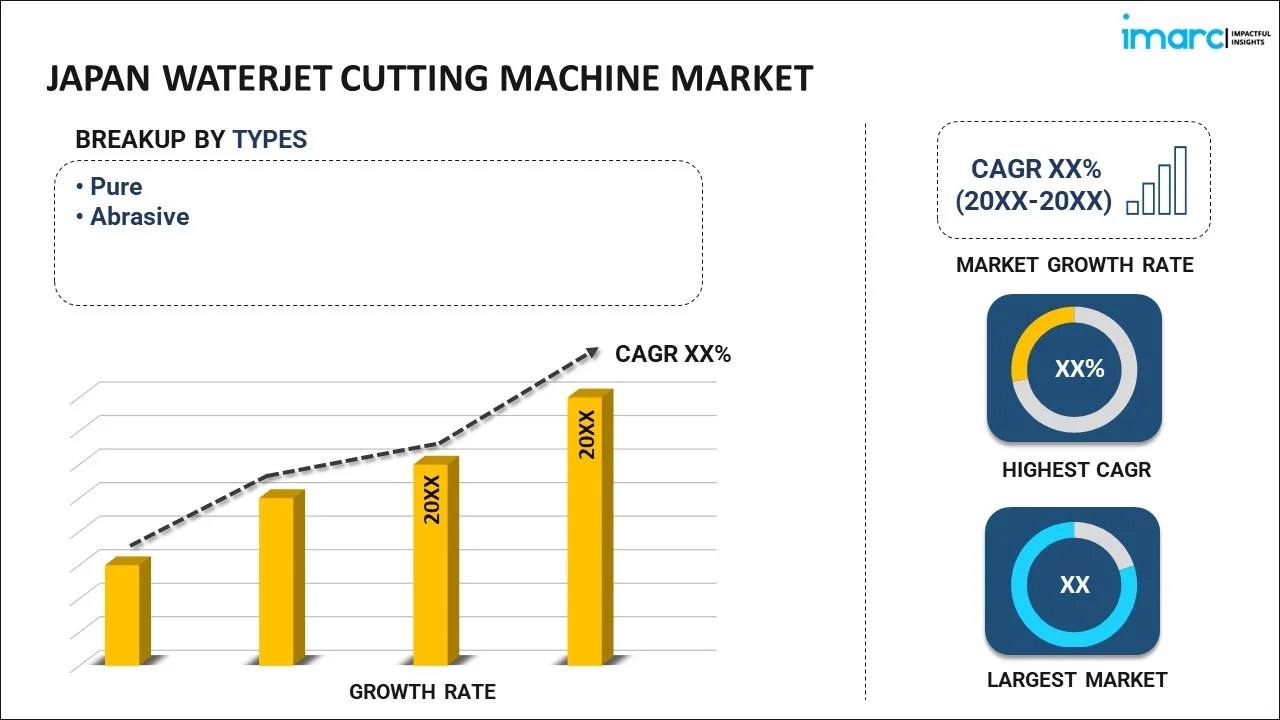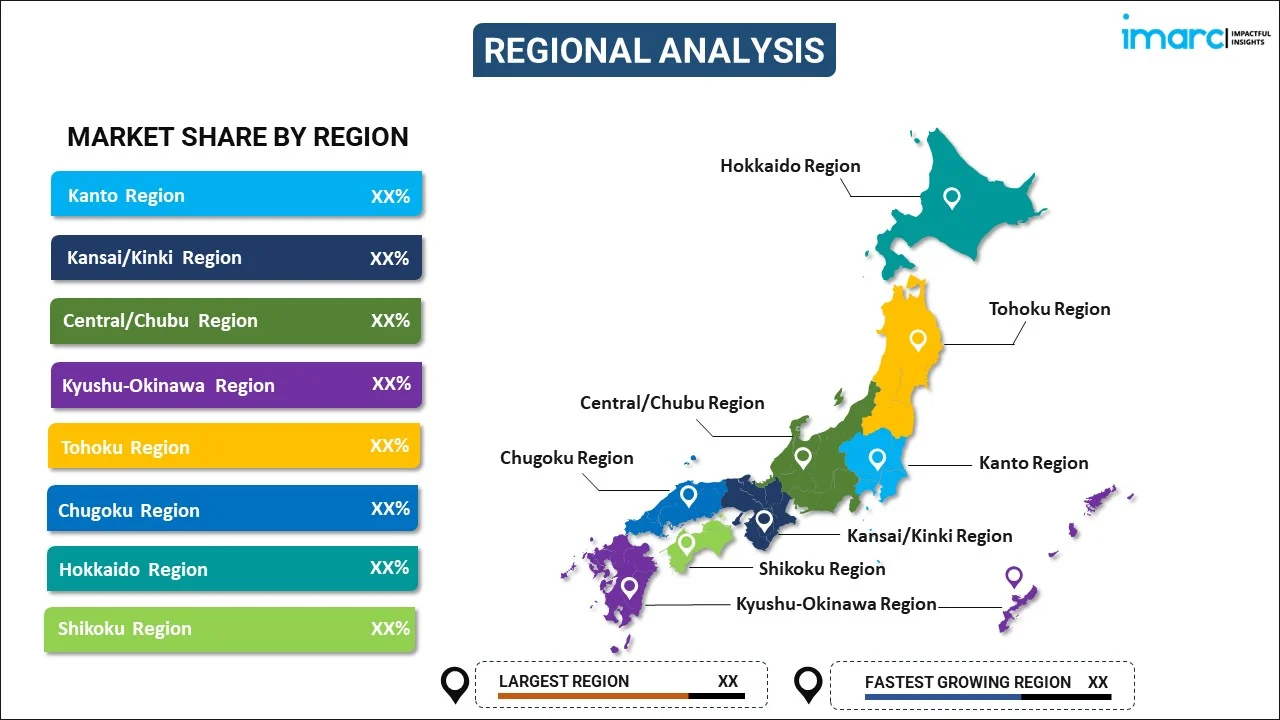
Japan Waterjet Cutting Machine Market Report by Type (Pure, Abrasive), Product Type (3D Waterjet Cutting, Micro Waterjet Cutting, Robotic Waterjet Cutting), Horsepower (0 to 50 HP, 51 to 100 HP, and Others), Machine Size (Small, Medium, Large), Application (Automotive, Electronics, Aerospace and Defense, Mining, Metal Fabrication, and Others), and Region 2025-2033
Market Overview:
Japan waterjet cutting machine market size reached USD 71.0 Million in 2024. Looking forward, IMARC Group expects the market to reach USD 114.0 Million by 2033, exhibiting a growth rate (CAGR) of 5.4% during 2025-2033. The widespread adoption of eco-friendly cutting processes and practices to produce metal gaskets is primarily driving the market growth.
|
Report Attribute
|
Key Statistics
|
|---|---|
|
Base Year
|
2024
|
|
Forecast Years
|
2025-2033
|
|
Historical Years
|
2019-2024
|
| Market Size in 2024 | USD 71.0 Million |
| Market Forecast in 2033 | USD 114.0 Million |
| Market Growth Rate 2025-2033 | 5.4% |
A waterjet cutting machine (WCM) is an industrial device that utilizes high-pressure water jet streams to precisely cut and shape various materials. These streams can consist of water alone or abrasive liquids, and they are capable of cutting through materials like metals, glass, foams, and reflective substances without causing melting, warping, or distortion of the original material structure. Importantly, these machines operate without the need for heat during the cutting process, making them suitable for materials that are sensitive to high temperatures. Additionally, they offer several advantages, including exceptionally precise cutting, the ability to cut a wide range of heterogeneous materials, and minimal water consumption. As a result of these benefits, waterjet cutting machines are widely used across multiple industries, including automotive, electronics, aerospace and defense, food and beverage, mining, metal fabrication, paper processing, textiles, and more.
Japan Waterjet Cutting Machine Market Trends:
Rapid industrialization witnessed on a wide scale stands as a pivotal driver of market expansion in Japan. Additionally, the market is experiencing substantial growth due to widespread adoption of waterjet cutting machines (WCMs) within the automobile industry. These machines are instrumental in producing various automotive components, including metal gaskets, brake disks, clutches, and intricate decorative fittings and brackets, thereby positively influencing the regional market. Furthermore, they play a vital role in the manufacturing of components constructed from composite materials for aircraft turbines and jet engines. Innovation in technology, such as the development of micro, 3D, and robotic product variants, which offer heightened cutting precision, constitutes another significant growth factor. Additionally, WCMs find application in the military and defense sector, where they are employed in the production of guided missiles, fuselages, and space vehicles. Apart from this, factors like rapid urbanization and the substantial growth observed in the industrial manufacturing and metal fabrication industries are poised to further propel market expansion in the coming years.
Japan Waterjet Cutting Machine Market Segmentation:
IMARC Group provides an analysis of the key trends in each segment of the market, along with forecasts at the country level for 2025-2033. Our report has categorized the market based on type, product type, horsepower, machine size, and application.
Type Insights:

- Pure
- Abrasive
The report has provided a detailed breakup and analysis of the market based on the type. This includes pure and abrasive.
Product Type Insights:
- 3D Waterjet Cutting
- Micro Waterjet Cutting
- Robotic Waterjet Cutting
A detailed breakup and analysis of the market based on the product type have also been provided in the report. This includes 3d waterjet cutting, micro waterjet cutting, and robotic waterjet cutting.
Horsepower Insights:
- 0 to 50 HP
- 51 to 100 HP
- Others
The report has provided a detailed breakup and analysis of the market based on the horsepower. This includes 0 to 50 HP, 51 to 100 HP, and others.
Machine Size Insights:
- Small
- Medium
- Large
A detailed breakup and analysis of the market based on the machine size have also been provided in the report. This includes small, medium, and large.
Application Insights:
- Automotive
- Electronics
- Aerospace and Defense
- Mining
- Metal Fabrication
- Others
The report has provided a detailed breakup and analysis of the market based on the application. This includes automotive, electronics, aerospace and defense, mining, metal fabrication, and others.
Regional Insights:

- Kanto Region
- Kansai/Kinki Region
- Central/ Chubu Region
- Kyushu-Okinawa Region
- Tohoku Region
- Chugoku Region
- Hokkaido Region
- Shikoku Region
The report has also provided a comprehensive analysis of all the major regional markets, which include Kanto Region, Kansai/Kinki Region, Central/ Chubu Region, Kyushu-Okinawa Region, Tohoku Region, Chugoku Region, Hokkaido Region, and Shikoku Region.
Competitive Landscape:
The market research report has also provided a comprehensive analysis of the competitive landscape. Competitive analysis such as market structure, key player positioning, top winning strategies, competitive dashboard, and company evaluation quadrant has been covered in the report. Also, detailed profiles of all major companies have been provided.
Japan Waterjet Cutting Machine Market Report Coverage:
| Report Features | Details |
|---|---|
| Base Year of the Analysis | 2024 |
| Historical Period | 2019-2024 |
| Forecast Period | 2025-2033 |
| Units | Million USD |
| Scope of the Report | Exploration of Historical and Forecast Trends, Industry Catalysts and Challenges, Segment-Wise Historical and Predictive Market Assessment:
|
| Types Covered | Pure, Abrasive |
| Product Types Covered | 3D Waterjet Cutting, Micro Waterjet Cutting, Robotic Waterjet Cutting |
| Horsepowers Covered | 0 to 50 HP, 51 to 100 HP, Others |
| Machine Sizes Covered | Small, Medium, Large |
| Applications Covered | Automotive, Electronics, Aerospace and Defense, Mining, Metal Fabrication, Others |
| Regions Covered | Kanto Region, Kansai/Kinki Region, Central/ Chubu Region, Kyushu-Okinawa Region, Tohoku Region, Chugoku Region, Hokkaido Region, Shikoku Region |
| Customization Scope | 10% Free Customization |
| Post-Sale Analyst Support | 10-12 Weeks |
| Delivery Format | PDF and Excel through Email (We can also provide the editable version of the report in PPT/Word format on special request) |
Key Questions Answered in This Report:
- How has the Japan waterjet cutting machine market performed so far and how will it perform in the coming years?
- What has been the impact of COVID-19 on the Japan waterjet cutting machine market?
- What is the breakup of the Japan waterjet cutting machine market on the basis of type?
- What is the breakup of the Japan waterjet cutting machine market on the basis of product type?
- What is the breakup of the Japan waterjet cutting machine market on the basis of horsepower?
- What is the breakup of the Japan waterjet cutting machine market on the basis of machine size?
- What is the breakup of the Japan waterjet cutting machine market on the basis of application?
- What are the various stages in the value chain of the Japan waterjet cutting machine market?
- What are the key driving factors and challenges in the Japan waterjet cutting machine?
- What is the structure of the Japan waterjet cutting machine market and who are the key players?
- What is the degree of competition in the Japan waterjet cutting machine market?
Key Benefits for Stakeholders:
- IMARC’s industry report offers a comprehensive quantitative analysis of various market segments, historical and current market trends, market forecasts, and dynamics of the Japan waterjet cutting machine market from 2019-2033.
- The research report provides the latest information on the market drivers, challenges, and opportunities in the Japan waterjet cutting machine market.
- Porter's five forces analysis assist stakeholders in assessing the impact of new entrants, competitive rivalry, supplier power, buyer power, and the threat of substitution. It helps stakeholders to analyze the level of competition within the Japan waterjet cutting machine industry and its attractiveness.
- Competitive landscape allows stakeholders to understand their competitive environment and provides an insight into the current positions of key players in the market.
Need more help?
- Speak to our experienced analysts for insights on the current market scenarios.
- Include additional segments and countries to customize the report as per your requirement.
- Gain an unparalleled competitive advantage in your domain by understanding how to utilize the report and positively impacting your operations and revenue.
- For further assistance, please connect with our analysts.
 Inquire Before Buying
Inquire Before Buying
 Speak to an Analyst
Speak to an Analyst
 Request Brochure
Request Brochure
 Request Customization
Request Customization




.webp)




.webp)












